
The mountain pygmy possum ; also simply known as the burramys, is a small, mouse-sized nocturnal marsupial of Australia found in dense alpine rock screes and boulder fields, mainly southern Victoria and around Mount Kosciuszko in Kosciuszko National Park in New South Wales at elevations from 1,300 to 2,230 metres. At almost 14 cm (5.5 in), its prehensile tail is longer than its 11 cm (4.3 in) combined head and body length. Its diet consists of insects, fleshy fruits, nuts, nectar and seeds. Its body is covered in a thick coat of fine grey fur except for its stomach, which is cream coloured; its tail is hairless. On the underside of the female's body is a pouch containing four teats. This possum is the only extant species in the genus Burramys. It is also the only Australian mammal restricted to alpine habitat.

Notodontidae is a family of moths with approximately 3,800 known species. The family was described by James Francis Stephens in 1829. Moths of this family are found in all parts of the world, but they are most concentrated in tropical areas, especially in the New World.
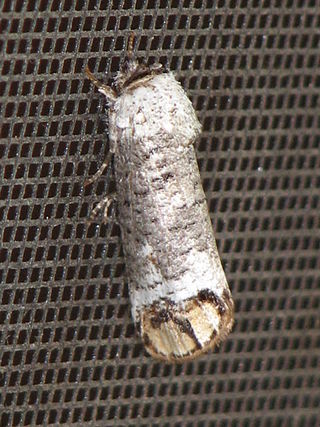
The Cossidae, the cossid millers or carpenter millers, make up a family of mostly large miller moths. This family contains over 110 genera with almost 700 known species, and many more species await description. Carpenter millers are nocturnal Lepidoptera found worldwide, except the Southeast Asian subfamily Ratardinae, which is mostly active during the day.

The dryandra moth is a species of moth that is considered to be the sole member of the family Carthaeidae. Its closest relatives are the Saturniidae and it bears a resemblance to many species of that family, bearing prominent eyespots on all wings. The common name is derived from the Dryandra shrubs of the genus Banksia, on which the larva of this species feed, and is hence restricted to the south-west of Western Australia where these shrubs grow. Other Grevillea shrubs may also be used as host plants.

The little broad-nosed bat translates to "Grey’s darkness creeper". Sometimes called Grey’s broad-nosed after the third governor of South Australia, Sir John Edward Grey. It is a species of vesper bat, which is one of the largest and best-known family of bats. They are endemic to Australia, are insectivores and have a broad range within the mainland, mainly in hot arid areas but also found in tropical rainforests.

Tinea pellionella, the case-bearing clothes moth, is a species of tineoid moth in the family Tineidae, the fungus moths. This species has a cosmopolitan distribution, occurring nearly worldwide.
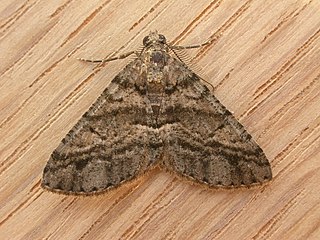
Lipogya eutheta, the grey bark moth, is a moth of the family Geometridae first described by Alfred Jefferis Turner in 1917. It is found in the Australian states of Queensland, New South Wales, and Victoria.

Circopetes is a monotypic moth genus in the family Geometridae erected by Louis Beethoven Prout in 1910. Its only species, Circopetes obtusata, the grey twisted moth, was first described by Francis Walker in 1860. It is found in mainland Australia.
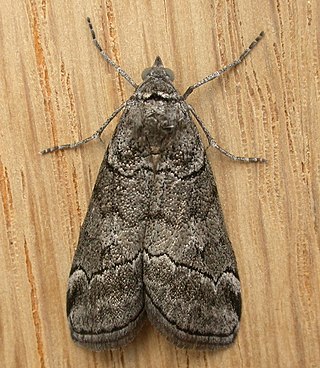
Corula is a monotypic moth genus in the family Geometridae. Its only species, Corula geometroides, the ash-grey geometrid, is found in Australia. Both the genus and species were first described by Francis Walker in 1856.

Abantiades latipennis, known as the Pindi moth, is a species of moth in the family Hepialidae. It may also be referred to as a swift moth or a ghost moth, as this is a common name associated with Hepialidae. Endemic to Australia and identified in 1932, it is most populous in temperate rainforest where eucalypti are prevalent, as the larvae feed primarily on the roots of these trees. Females lay eggs during flight in a scattering fashion. The larvae live for over eighteen months underground, while adult moths survive for approximately one week, as they have no mouthparts with which to feed. The moths are preyed upon by a number of predators, including bats and owls. Brown in colour overall, males are paler and the identifying silver bars of the male's wings are more prominent than those of the female's, with dark margins. Male adults are generally smaller.

Thyas coronata is a species of moth of the family Erebidae first described by Johan Christian Fabricius in 1775. It is found from the Indo-Australian tropics of southern China, Taiwan, Japan, Nepal, India, Sri Lanka to Micronesia and the Society Islands.

Ophiusa disjungens, the guava moth, is a moth of the family Erebidae. The species was first described by Francis Walker in 1858. It is found in south-east Asia and the south Pacific, including Thailand, Japan, Tonga and New South Wales and Queensland. The adult is a fruit piercer.

Leucania loreyi, the cosmopolitan, false army worm or nightfeeding rice armyworm, is a moth of the family Noctuidae. It is found in most of African countries, the Indo-Australian subtropics and tropics of India, Sri Lanka, Myanmar, the eastern Palearctic realm, and the Near East and Middle East. The species was first described by Philogène Auguste Joseph Duponchel in 1827.
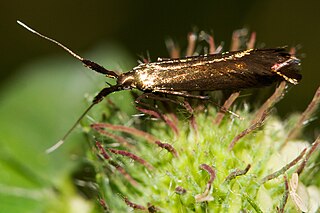
Coleophora deauratella is a moth of the family Coleophoridae. It is found in most of Europe, Asia Minor, Tasmania, North America and New Zealand.
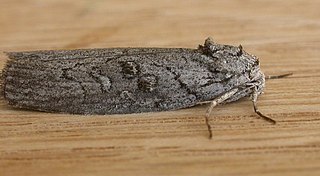
Elesma subglauca, the grey elesma, is a moth of the family Noctuidae first described by Francis Walker in 1865. It is found in the southern half of Australia.

Ctenoplusia albostriata, the eastern streaked plusia, is a moth of the family Noctuidae. It is found in India, Sri Lanka, eastern Asia and the Pacific, including Borneo, Hong Kong, Vietnam, Japan, most of Australia and New Zealand.

Platyja umminia is a species of moth in the family Noctuidae first described by Pieter Cramer in 1780. It is found from the Indo-Australian tropics of China, Japan, India, Sri Lanka, Myanmar to New Guinea and Queensland. It is also present on Guam. Adults have been recorded piercing fruit in Thailand and Guam.

Serrodes campana is a species of moth of the family Erebidae first described by Achille Guenée in 1852. It is found from the Indo-Australian tropics to eastern Australia, Fiji, Samoa and New Caledonia. It is also present in Japan, Korea and Sri Lanka. The adult is a fruit piercer, but also feeds on flower nectar.
Pingasa cinerea, the tan-spotted grey, is a moth of the family Geometridae. The species was first described by William Warren in 1894. It is found in the Australian states of New South Wales, Queensland, Tasmania and Victoria.
The Buluwai are an indigenous Australian people of the state of Queensland.
















